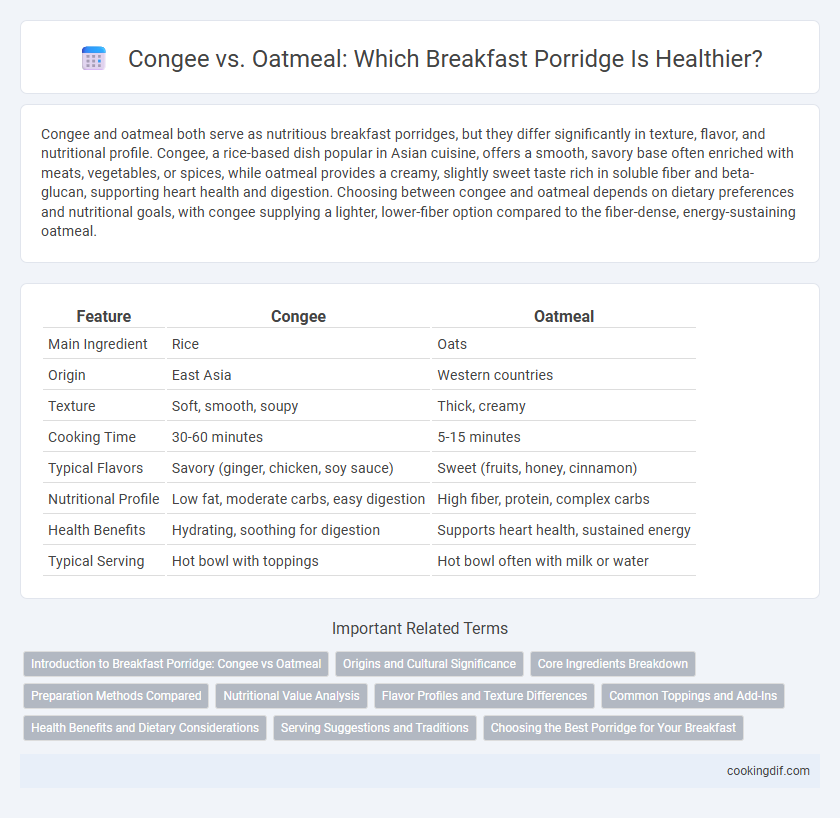Congee and oatmeal both serve as nutritious breakfast porridges, but they differ significantly in texture, flavor, and nutritional profile. Congee, a rice-based dish popular in Asian cuisine, offers a smooth, savory base often enriched with meats, vegetables, or spices, while oatmeal provides a creamy, slightly sweet taste rich in soluble fiber and beta-glucan, supporting heart health and digestion. Choosing between congee and oatmeal depends on dietary preferences and nutritional goals, with congee supplying a lighter, lower-fiber option compared to the fiber-dense, energy-sustaining oatmeal.
Table of Comparison
| Feature | Congee | Oatmeal |
|---|---|---|
| Main Ingredient | Rice | Oats |
| Origin | East Asia | Western countries |
| Texture | Soft, smooth, soupy | Thick, creamy |
| Cooking Time | 30-60 minutes | 5-15 minutes |
| Typical Flavors | Savory (ginger, chicken, soy sauce) | Sweet (fruits, honey, cinnamon) |
| Nutritional Profile | Low fat, moderate carbs, easy digestion | High fiber, protein, complex carbs |
| Health Benefits | Hydrating, soothing for digestion | Supports heart health, sustained energy |
| Typical Serving | Hot bowl with toppings | Hot bowl often with milk or water |
Introduction to Breakfast Porridge: Congee vs Oatmeal
Congee and oatmeal are popular breakfast porridges with distinct cultural and nutritional profiles. Congee, a rice-based dish common in Asian cuisine, offers a savory and easily digestible option rich in carbohydrates and hydration. Oatmeal, derived from oats, provides a high-fiber, protein-rich alternative that supports heart health and sustained energy release.
Origins and Cultural Significance
Congee, a staple in many Asian cuisines, originated in China over two millennia ago and is traditionally made by simmering rice until it forms a creamy porridge, symbolizing comfort and nourishment during cold seasons or illness. Oatmeal, with its roots in ancient Scotland, is made from oats and historically served as a hearty, energy-rich breakfast that sustained farmers and laborers, becoming a symbol of rustic simplicity in Western culture. Both porridge varieties reflect their regions' agricultural practices and cultural values, highlighting rice's prominence in Asia and oats in Europe as essential grains.
Core Ingredients Breakdown
Congee is a traditional Asian porridge made primarily from rice, cooked slowly in a large amount of water until it breaks down into a smooth, creamy texture, often accompanied by savory toppings like chicken, ginger, or scallions. Oatmeal consists of oats, typically rolled or steel-cut, simmered in water or milk to create a thicker, heartier porridge with a mild nutty flavor, often enhanced with sweet ingredients like fruits, nuts, or honey. The core ingredient differences -- rice for congee and oats for oatmeal -- dictate their nutritional profiles, textures, and cultural pairings, making each suitable for distinct breakfast preferences.
Preparation Methods Compared
Congee is traditionally prepared by simmering rice in a large volume of water for several hours until it reaches a smooth, creamy consistency, often incorporating ingredients like ginger, chicken, or century eggs for added flavor. Oatmeal is typically made by boiling rolled or steel-cut oats in water or milk for a shorter time, usually 5 to 20 minutes, resulting in a thicker, creamier texture depending on oat variety and cooking time. The key difference lies in congee's longer cooking period and higher water ratio, which produces a softer, more fluid porridge compared to the denser, quicker-cooked oatmeal.
Nutritional Value Analysis
Congee, made from rice, offers a low-calorie, easily digestible breakfast porridge rich in carbohydrates and a modest amount of protein, making it ideal for a light start to the day. Oatmeal provides higher fiber content, significant beta-glucans, and a more substantial protein profile, supporting heart health and sustained energy release. Both porridge options provide essential nutrients, but oatmeal delivers greater dietary fiber and protein density compared to congee's gentle digestibility and lower glycemic impact.
Flavor Profiles and Texture Differences
Congee offers a mild, savory flavor with a smooth, creamy texture that is often enhanced by savory toppings like scallions and soy sauce. Oatmeal has a naturally nutty taste and a thicker, chewier consistency, providing a heartier mouthfeel. Both porridges serve as versatile breakfast options but diverge significantly in taste and texture, catering to different flavor preferences and dietary needs.
Common Toppings and Add-Ins
Congee and oatmeal both serve as versatile breakfast porridges, with common toppings and add-ins reflecting their cultural roots. Congee frequently incorporates savory ingredients like scallions, soy sauce, century eggs, and shredded chicken, enhancing its umami flavor and texture. Oatmeal toppings often include sweet options such as fresh fruits, nuts, honey, cinnamon, and yogurt, providing a nutrient-rich and balanced start to the day.
Health Benefits and Dietary Considerations
Congee, a traditional rice porridge, is low in fat and gluten-free, making it ideal for those with gluten intolerance or digestive issues, while offering hydration and easy digestion. Oatmeal is rich in soluble fiber, especially beta-glucan, which helps lower cholesterol levels and stabilizes blood sugar, supporting heart health and weight management. Both options provide essential nutrients, but oatmeal is higher in protein and antioxidants, whereas congee provides a gentle, easily digestible base suitable for sensitive stomachs.
Serving Suggestions and Traditions
Congee, a traditional Asian rice porridge, is often served with savory accompaniments like pickled vegetables, century eggs, or shredded chicken, reflecting its role in culturally rich breakfast rituals. Oatmeal, popular in Western diets, is commonly sweetened with fruits, nuts, and honey, showcasing its adaptability to diverse flavor preferences and health-conscious habits. Serving styles highlight regional tastes, with congee emphasizing warmth and umami, while oatmeal balances texture and sweetness for a comforting morning meal.
Choosing the Best Porridge for Your Breakfast
Congee, a traditional Asian rice porridge, offers a light, easily digestible option rich in hydration and mild flavors, ideal for those seeking a gentle start to the day. Oatmeal provides a hearty, fiber-packed alternative packed with beta-glucan that supports heart health and sustained energy release. Choosing between congee and oatmeal depends on nutritional goals, taste preferences, and desired texture for a satisfying breakfast porridge experience.
Congee vs Oatmeal for breakfast porridge Infographic

 cookingdif.com
cookingdif.com